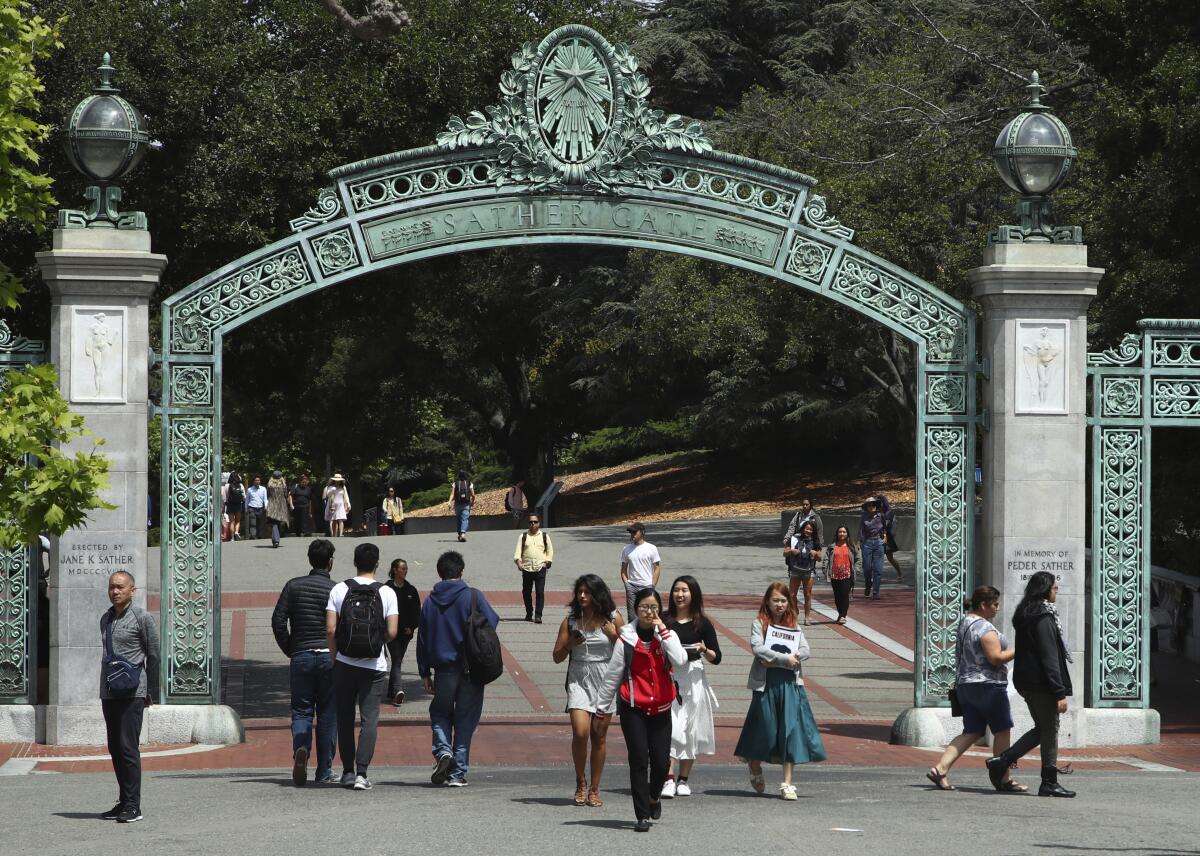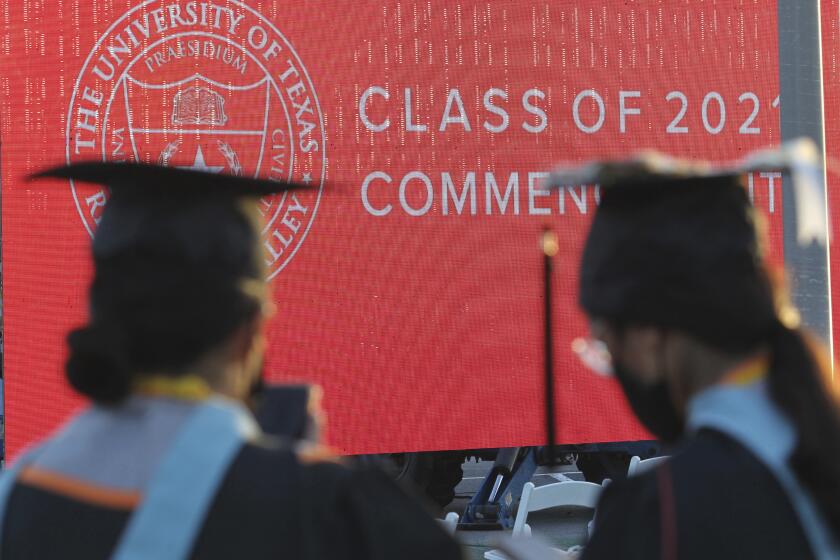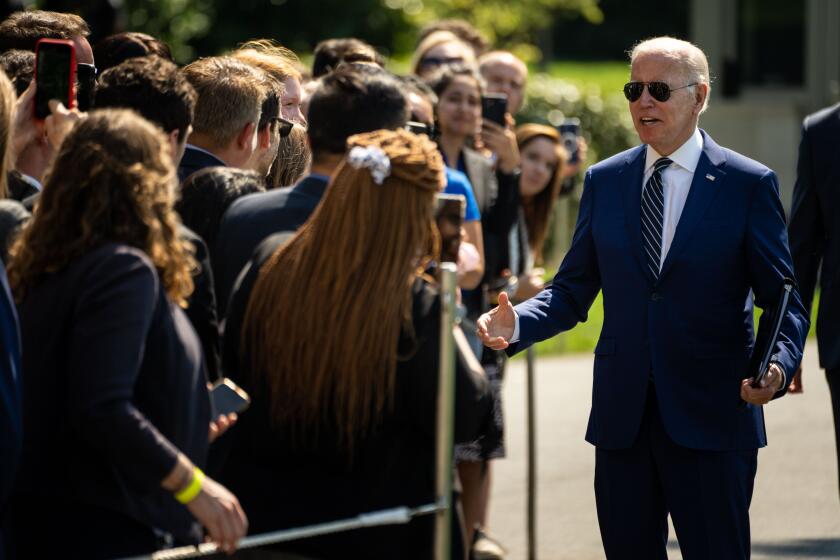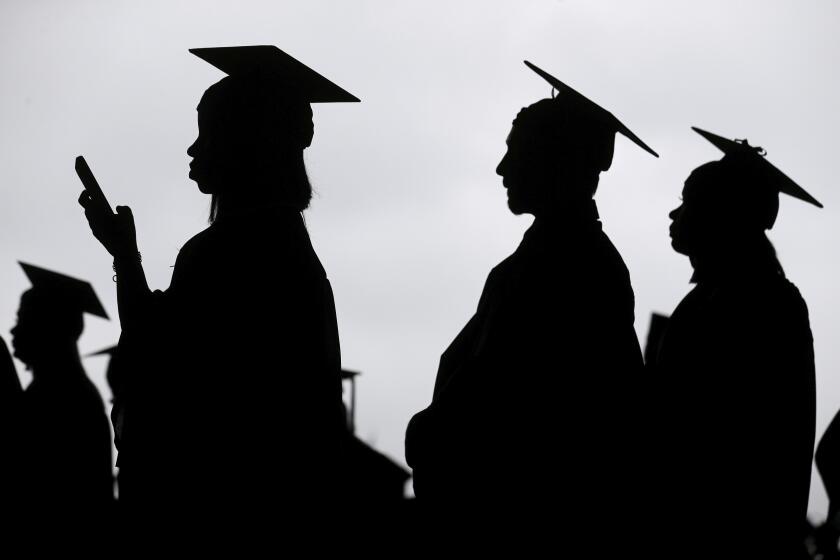Student loan forgiveness applications now open online. Here are the details

- Share via
The U.S. Department of Education officially opened the window Monday to applications for student loan debt relief, following a weekend test of the online application form.
President Biden announced the formal launch of the applications Monday afternoon, saying, “We’re going to make sure the system works as smoothly as possible.” During the “beta test” of the online form (https://studentaid.gov/debt-relief/application), Biden said, more than 8 million people successfully submitted applications in less than three days.
About 40 million people with federal student loans stand to benefit from the one-time debt relief program, Biden said. Borrowers who meet the income limits — less than $125,000 in either 2020 or 2021 for a single taxpayer, or less than $250,000 for a couple filing jointly — will be eligible for up to $10,000 in federal student loan forgiveness, or up to $20,000 if they received a Pell Grant.
“Not a dime will go to people in the top 5% income bracket,” Biden said. Some critics of the blanket forgiveness say it will benefit many college graduates in high-paying fields.
The weekend beta test was aimed at avoiding the problems the department encountered after the White House first announced the debt relief plan in August, when borrowers experienced long delays or could not access an overwhelmed studentaid.gov website
The department has said that most borrowers will not have to submit an application form to obtain the loan forgiveness. The relief will be offered automatically to you if you’ve already reported your income to the Department of Education — for example, as part of an income-driven repayment plan.
Biden stressed that the form, which is due by the end of 2023, is simple to fill out and requires no documents to be submitted. It asks for so little information, in fact, you could fill it out on a smartphone in minutes.
The application asks only for your name (or former name, if that’s what is on your loan records), Social Security number, date of birth, phone number and email address. Instead of requesting copies of tax returns or other financial records, the form simply asks you to attest, under penalty of perjury, that you met the program’s income limits.
Specifically, you have to attest that at least one of the following things was true in 2020 or 2021:
• You made less than the income required to file federal taxes;
• You were a single tax filer or you filed a return separately from your spouse, and you made less than $125,000;
• You were a married person filing a joint return, a head of household or a qualifying widow or widower, and you made less than $250,000.
The form states that the department may ask you to submit proof of your income, which you’ll have to do by March 31, 2024.
One wrinkle not mentioned on the application form is that if your parents claimed you as a dependent on their federal income tax form, their income, not yours, may determine whether you’re eligible for the one-time relief. According to studentaid.gov, “if you were enrolled in school as a dependent student for financial aid purposes between July 1, 2021, and June 30, 2022, your eligibility is based on parent income.”
If you fall into that category, the department said, it will contact you after it receives your application form to have your parent submit a “Parent Income Form.”
Biden urged borrowers to be wary of fraudsters offering to help you apply for relief. If you get a call from someone purporting to be from the government seeking to guide you through the process, Biden said, “let’s be clear: Hang up.” You can report such scams at the Federal Trade Commission’s website, reportfraud.ftc.gov.
President Biden’s loan forgiveness plan papered over some of the financial aid complexities. Here’s how to figure out if your loan may be eligible.
Which loans are eligible?
The forgiveness applies only to loans issued or held by the federal government. It doesn’t extend to loans issued or held by private lenders.
Generally, if the payments and interest on your student-loan debt are still paused because of the pandemic, that debt is eligible for forgiveness.
Some Federal Family Education Loans and Perkins Loans, which are guaranteed by the federal government, are held by private lenders and are not eligible for forgiveness. To determine whether your loan is held by the government or by a private lender, sign in to your account at studentaid.gov and call up the “My Loan Servicers” list. If the servicer’s name is preceded by “DEPT OF ED,” that loan is held by the federal government.
If you consolidated or applied to consolidate privately held FFEL or Perkins loans into a federal direct loan before Sept. 29, the consolidated loan should be eligible for the one-time forgiveness program.
If you have more than one eligible loan, the department said it will apply relief in this order of priority:
- Defaulted loans it holds
- Defaulted Federal Family Education Loans held by private lenders
- Non-defaulted direct loans
- FFELs and Perkins loans held by the department.
Within each of those categories, forgiveness will be applied first to loans with the highest interest rate, with unsubsidized loans taking precedence over subsidized loans and more recent loans over older ones.
Can you opt out?
No one is required to accept the loan forgiveness, which would be considered taxable income in some states. If you qualify automatically for relief, the department said, it will email you to confirm that you want to accept it before forgiving the applicable amount of your debt.
The Biden administration’s student loan relief plan is expected to wipe out the debt of 1 million or more Californians. Here’s who is eligible and for how much forgiveness.
What happens after you apply?
The department said it will email you to confirm that it received your application. If it needs more information, such as proof of your income or your parents’ income, it will ask for it. And if the department determines that you do not qualify, it will contact you with the bad news.
When will my debt be reduced?
If your application is approved, the department said, it will notify the company or companies servicing your loans about the reduction in your debt. But the department’s website cautions that “it may take some time for your account to reflect this change.”
The relief is expected to arrive before federal student loan payments, which were put on hold during the pandemic, are set to resume in January. Your servicer or servicers will let you know what your new balance is and, if you have remaining debt, what your monthly payment will be.
If you’re on an income-driven repayment plan, your income, not the amount you owe, will dictate your payment amount. If you are on a standard payment plan, the department said, your servicer will reduce your monthly payments to reflect the lower balance. You can opt to write a bigger monthly check to pay off the loan faster and reduce the amount of interest you’ll pay over the life of the loan.
Again, if you don’t qualify automatically for relief, you have until the end of 2023 to submit an application form. The longer you wait, the longer you delay any reduction in your monthly payments.
Will debt relief for student loans be taxable in California? Experts say yes, but the state Franchise Tax Board isn’t giving a definitive answer.
Will the debt relief be taxable?
Under federal law, the amount of loan forgiveness you receive will not be considered taxable income by the Internal Revenue Service. But it will be considered taxable income in California, the state Franchise Tax Board has said, unless legislators change state law.
That’s because state lawmakers didn’t conform California tax law to the 2021 American Rescue Plan, which excluded all forgiven student-loan debt from federal taxes. Instead, state law excludes only debt forgiven as part of an income-driven payment plan or public-service loan forgiveness program.
In a tweet last month, the state’s two top lawmakers pledged to push through legislation early next year to prevent the state from taxing the loan amounts forgiven by the Biden administration.
Can I get a refund for past payments?
If you owe less than $10,000 in federal loans (or $20,000, if you received a Pell Grant), the one-time relief will wipe out that debt, but you won’t receive a check for any amount left over.
However, if you’ve been making student-loan payments voluntarily during the pandemic, you’ll get that money back automatically. The amount you’ll receive in forgiveness and refunded payments is capped at $10,000 (or $20,000 for Pell Grant recipients).
The department also said it won’t refund any of the voluntary payments you made if your federal student loan debt is greater than $10,000 (or $20,000 for Pell Grant recipients). All the relief will be applied to your loan debt.
Is there anything that could block the debt relief?
At least two federal lawsuits have been filed by conservative opponents of the loan-forgiveness program, which the Congressional Budget Office estimated would cost taxpayers $400 billion. A court could enjoin the department from carrying out the debt relief until the legal issues are resolved.
A common argument against the debt relief is that blanket loan forgiveness can be done only through an act of Congress. For its part, the Department of Justice asserts that the HEROES Act, a post-9/11 law enacted to help service members deployed to Iraq and Afghanistan, authorizes the administration to cancel student loan debt broadly during times of emergency, such as the pandemic.
Biden defended the debt relief plan as “economically responsible” and criticized Republicans for trying to deny help “even to their own constituents.”
More to Read
Sign up for Essential California
The most important California stories and recommendations in your inbox every morning.
You may occasionally receive promotional content from the Los Angeles Times.














